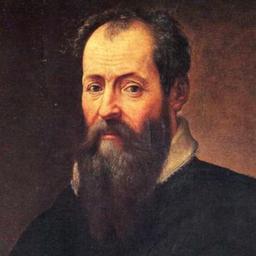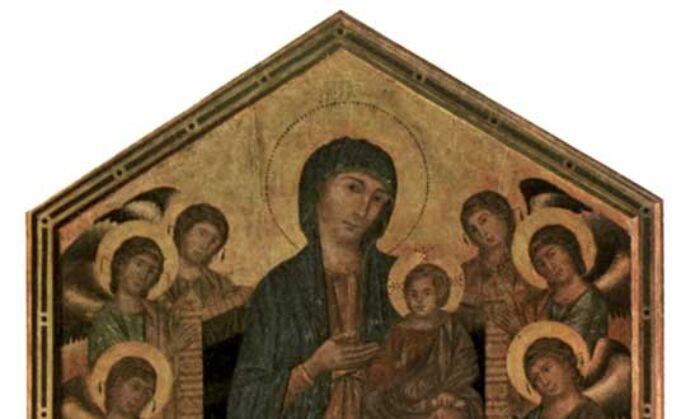Of very great advantage to architecture, in truth, was the new method of Filippo Brunelleschi, who imitated and restored to the light, after many ages, the noble works of the most learned and marvellous ancients. But no less useful to our age was Bramante, in following the footsteps of Filippo, and making the path of his profession of architecture secure for all who came after him, by means of his courage, boldness, intellect, and science in that art, wherein he had the mastery not of theory only, but of supreme skill and practice. Nor could nature have created a more vigorous intellect, or one to exercise his art and carry it into execution with greater invention and proportion, or with a more thorough knowledge, than Bramante. But no less essential than all this was the election to the Pontificate, at that time, of Julius II, a Pope of great spirit, full of desire to leave memorials behind him. And it was fortunate both for us and for Bramante that he found such a Prince (a thing which rarely happens to men of great genius), at whose expense he might be able to display the worth of his intellect, and that mastery over difficulties which he showed in architecture. His ability was so universal in the buildings that he erected, that the outlines of the cornices, the shafts of the columns, the graceful capitals, the bases, the consoles and corners, the vaults, the staircases, the projections, and every detail of every Order of architecture, contrived from the counsel or model of this craftsman, never failed to astonish all who saw them. Wherefore it appears to me that the everlasting gratitude which is due to the ancients from the intellects that study their works, is also due from them to the labours of Bramante; for if the Greeks were the inventors of architecture,
and the Romans their imitators, Bramante not only imitated what he saw, with new invention, and taught it to us, but also added very great beauty and elaboration to the art, which we see embellished by him at the present day.
He was born at Castel Durante, in the State of Urbino, of poor but honest parentage. In his boyhood, besides reading and writing, he gave much attention to arithmetic; but his father, who had need that he should earn money, perceiving that he delighted much in drawing, applied him, when still a mere boy, to the art of painting; whereupon Bramante gave much study to the works of Fra Bartolommeo, otherwise called Fra Carnovale da Urbino, who painted the panel-picture of S. Maria della Bella at Urbino. But since he always delighted in architecture and perspective, he departed from Castel Durante, and made his way to Lombardy, where he went now to one city, and now to another, working as best he could, but not on things of great cost or much credit, having as yet neither name nor reputation. For this reason he determined at least to see some noteworthy work, and betook himself to Milan, in order to see the Duomo. In that city there was then living one Cesare Cesariano, reputed to be a good geometrician and an able architect, who wrote a commentary on Vitruvius, and, out of despair at not having received for this the remuneration that he had expected, became so strange that he would work no more; and, having grown almost savage, he died more like a beast than like a human being. There was also one Bernardino da Trevio, a Milanese, engineer and architect for the Duomo, and an excellent draughtsman, who was held by Leonardo da Vinci to be a rare master, although his manner was rather crude and somewhat hard in painting. By his hand is a Resurrection of Christ to be seen at the upper end of the cloister of the Grazie, with some very beautiful foreshortenings; and a chapel in fresco in S. Francesco, containing the deaths of S. Peter and S. Paul. He painted many other works in Milan, and he also made a good number in the surrounding district, which are held in esteem; and in our book there is a head of a very beautiful woman, in charcoal and lead-white, which still bears witness to the manner that he followed.
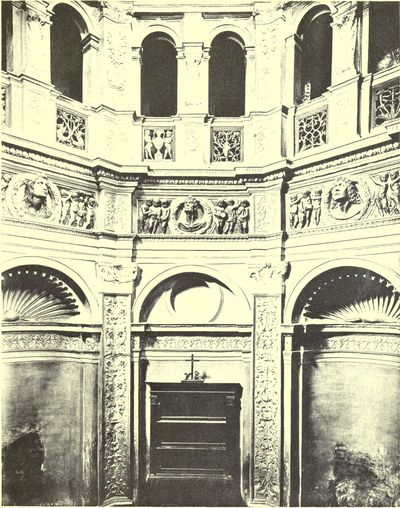
Interior of Sacristy
(After Bramante da Urbino. Milan: S. Satiro)
Brogi
But to return to Bramante; having studied that building, and having come to know those engineers, he so took courage, that he resolved to devote himself wholly to architecture. Having therefore departed from Milan, he betook himself, just before the holy year of 1500, to Rome, where he was recognized by some friends, both from his own country and from Lombardy, and received a commission to paint, over the Porta Santa of S. Giovanni Laterano, which is opened for the Jubilee, the coat of arms of Pope Alexander VI, to be executed in fresco, with angels and other figures acting as supporters.
Bramante had brought some money from Lombardy, and he earned some more in Rome by executing certain works; and this he spent with the greatest economy, since he wished to be able to live independently, and at the same time, without having to work, to be free to take measurements, at his ease, of all the ancient buildings in Rome. And having put his hand to this, he set out, alone with his thoughts; and within no great space of time he had measured all the buildings in that city and in the Campagna without; and he went as far as Naples, and wherever he knew that there were antiquities. He measured all that was at Tivoli and in the Villa of Hadrian, and, as will be related afterwards in the proper place, made great use of it. The mind of Bramante becoming known in this way, the Cardinal of Naples, having noticed him, began to favour him. Whereupon, while Bramante was continuing his studies, the desire came to the said Cardinal to have the cloister of the Frati della Pace rebuilt in travertine, and he gave the charge of this cloister to Bramante, and he, desiring to earn money and to gain the good will of that Cardinal, set himself to work with all possible industry and diligence, and brought it quickly to perfect completion. And although it was not a work of perfect beauty, it gave him a very great name, since there were not many in Rome who followed the profession of architecture with such zeal, study, and resolution as Bramante.
At the beginning he served as under-architect to Pope Alexander VI for the fountain of Trastevere, and likewise for that which was made on the Piazza di S. Pietro. He also took part, together with other excellent architects, when his reputation had increased, in the planning
of a great part of the Palace of S. Giorgio, and of the Church of S. Lorenzo in Damaso, at the commission of Raffaello Riario, Cardinal of S. Giorgio, near the Campo di Fiore; which palace, whatever better work may have been executed afterwards, nevertheless was and still is held, on account of its greatness, to be a commodious and magnificent habitation; and the building of this edifice was carried out by one Antonio Montecavallo. Bramante was consulted with regard to the enlargement of S. Jacopo degli Spagnuoli, on the Piazza Navona, and likewise in the deliberations for the building of S. Maria de Anima, which was afterwards carried out by a German architect. From his design, also, was the Palace of Cardinal Adriano da Corneto in the Borgo Nuovo, which was built slowly, and then finally remained unfinished by reason of the flight of that Cardinal; and in like manner, the enlargement of the principal chapel of S. Maria del Popolo was executed from his design.
These works brought him so much credit in Rome, that he was considered the best architect, in that he was resolute, prompt, and most fertile in invention; and he was continually employed by all the great persons in that city for their most important undertakings. Wherefore, after Julius II had been elected Pope, in the year 1503, he entered into his service. The fancy had taken that Pontiff to so transform the space that lay between the Belvedere and the Papal Palace, as to give it the aspect of a square theatre, embracing a little valley that ran between the old Papal Palace and the new buildings that Innocent VIII had erected as a habitation for the Popes; and he intended, by means of two corridors, one on either side of this little valley, to make it possible to go from the Belvedere to the Palace under loggie, and also to go from the Palace to the Belvedere in the same way, and likewise, by means of various flights of steps, to ascend to the level of the Belvedere. Whereupon Bramante, who had very good judgment and an inventive genius in such matters, distributed two ranges of columns along the lowest part; first, a very beautiful Doric loggia, similar to the Colosseum of the Savelli (although, in place of half-columns, he used pilasters), and all built of travertine; and over this a second range of the Ionic Order, full of windows, of such a height as to come to the level of the first-floor rooms
of the Papal Palace, and to the level of those of the Belvedere; intending to make, afterwards, a loggia more than four hundred paces long on the side towards Rome, and likewise another on the side towards the wood, with which, one on either hand, he proposed to enclose the valley; into which, after it had been levelled, was to be brought all the water from the Belvedere; and for this a very beautiful fountain was to be made. Of this design, Bramante finished the first corridor, which issues from the Palace and leads to the Belvedere on the side towards Rome, except the upper loggia, which was to go above it. As for the opposite part, on the side towards the wood, the foundations, indeed, were laid, but it could not be finished, being interrupted by the death of Julius, and then by that of Bramante. His design was held to be so beautiful in invention, that it was believed that from the time of the ancients until that day, Rome had seen nothing better. But of the other corridor, as has been said, he left only the foundations, and the labour of finishing it has dragged on down to our own day, when Pius IV has brought it almost to completion.
Bramante also erected the head-wall of the Museum of ancient statues in the Belvedere, together with the range of niches; wherein were placed, in his lifetime, the Laocoon, one of the rarest of ancient statues, the Apollo, and the Venus; and the rest of the statues were set up there afterwards by Leo X, such as the Tiber, the Nile, and the Cleopatra, with some others added by Clement VII; and in the time of Paul III and Julius III many important improvements were made, at great expense.
But to return to Bramante; he was very resolute, although he was hindered by the avarice of those who supplied him with the means to work, and he had a marvellous knowledge of the craft of building. This construction at the Belvedere was executed by him with extraordinary speed, and such was his eagerness as he worked, and that of the Pope, who would have liked to see the edifice spring up from the ground, without needing to be built, that the builders of the foundations brought the sand and the solid foundation-clay by night and let
[14] it down by day in the presence of Bramante, who caused the foundations to be made
without seeing anything more of the work. This inadvertence was the reason that all his buildings have cracked, and are in danger of falling down, as did this same corridor, of which a piece eighty braccia in length fell to the ground in the time of Clement VII, and was afterwards rebuilt by Pope Paul III, who also had the foundations restored and the whole strengthened.
From his design, also, are many flights of steps in the Belvedere, varied according to their situations, whether high or low, in the Doric, Ionic, and Corinthian Orders—a very beautiful work, executed with extraordinary grace. And he had made a model for the whole, which is said to have been a marvellous thing, as may still be imagined from the beginning of the work, unfinished as it is. Moreover, he made a spiral staircase upon mounting columns, in such a way that one can ascend it on horseback; wherein the Doric passes into the Ionic, and the Ionic into the Corinthian, rising from one into the other; a work executed with supreme grace, and with truly excellent art, which does him no less honour than any other thing by his hand that is therein. This invention was copied by Bramante from S. Niccolò at Pisa, as was said in the Lives of Giovanni and Niccola of Pisa.
The fancy took Bramante to make, in a frieze on the outer façade of the Belvedere, some letters after the manner of ancient hieroglyphics, representing the name of the Pope and his own, in order to show his ingenuity: and he had begun thus, “Julio II, Pont. Massimo,” having caused a head in profile of Julius Cæsar to be made, and a bridge, with two arches, which signified, “Julio II, Pont.,” and an obelisk from the Circus Maximus, to represent “Max.” At which the Pope laughed, and caused him to make the letters in the ancient manner, one braccio in height, which are there at the present day; saying that he had copied this folly from a door at Viterbo, over which one Maestro Francesco, an architect, had placed his name, carved in the architrave, and represented by a S. Francis (S. Francesco), an arch (arco), a roof (tetto), and a tower (torre), which, interpreted in his own way, denoted, “Maestro Francesco Architettore.” The Pope, on account of his ability in architecture, was very well disposed towards him.
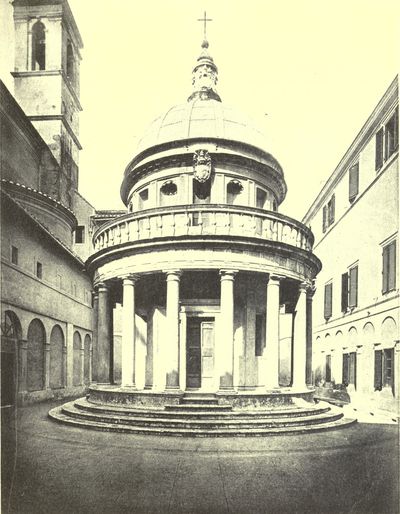
Tempietto
(After Bramante da Urbino. Rome: S. Pietro in Montorio)
Anderson
For these reasons he was rightly held worthy by the aforesaid Pope, who loved him very dearly for his great gifts, to be appointed to the Office of the Piombo, for which he made a machine for printing Bulls, with a very beautiful screw. In the service of that Pontiff Bramante went to Bologna, in the year 1504, when that city returned to the Church; and he occupied himself, throughout the whole war against Mirandola, on many ingenious things of the greatest importance. He made many designs for ground-plans and complete buildings, which he drew very well; and of such there are some to be seen in our book, accurately drawn and executed with very great art. He taught many of the rules of architecture to Raffaello da Urbino; designing for him, for example, the buildings that Raffaello afterwards drew in perspective in that apartment of the Pope wherein there is Mount Parnassus; in which apartment he made a portrait of Bramante taking measurements with a pair of compasses.
The Pope resolved, having had the Strada Julia straightened out by Bramante, to place in it all the public offices and tribunals of Rome, on account of the convenience which this would bring to the merchants in their business, which up to that time had always been much hindered. Wherefore Bramante made a beginning with the palace that is to be seen by S. Biagio sul Tevere, wherein there is still an unfinished Corinthian temple, a thing of rare excellence. The rest of this beginning is in rustic work, and most beautiful; and it is a great pity that a work so honourable, useful, and magnificent, which is held by the masters of the profession to be the most beautiful example of design in that kind that has ever been seen, should not have been finished. He made, also, in the first cloister of S. Pietro a Montorio, a round temple of travertine, than which nothing more shapely or better conceived, whether in proportion, design, variety, or grace, could be imagined; and even more beautiful would it have been, if the whole extent of the cloister, which is not finished, had been brought to the form that is to be seen in a drawing by his hand. He directed the building, in the Borgo, of the palace which afterwards belonged to Raffaello da Urbino, executed with bricks and mould-castings, the columns and bosses being of the Doric Order and of rustic
work—a very beautiful work—with a new invention in the making of these castings. He also made the design and preparations for the decoration of S. Maria at Loreto, which was afterwards continued by Andrea Sansovino; and an endless number of models for palaces and temples, which are in Rome and throughout the States of the Church.
So sublime was the intellect of this marvellous craftsman, that he made a vast design for restoring and rearranging the Papal Palace. And so greatly had his courage grown, on seeing the powers and desires of the Pope rise to the level of his own wishes and genius, that, hearing that he was minded to throw the Church of S. Pietro to the ground, in order to build it anew, he made him an endless number of designs. And among those that he made was one that was very wonderful, wherein he showed the greatest possible judgment, with two bell-towers, one on either side of the façade, as we see it in the coins afterwards struck for Julius II and Leo X by Caradosso, a most excellent goldsmith, who had no peer in making dies, as may still be seen from the medal of Bramante, executed by him, which is very beautiful. And so, the Pope having resolved to make a beginning with the vast and sublime structure of S. Pietro, Bramante caused half of the old church to be pulled down, and put his hand to the work, with the intention that it should surpass, in beauty, art, invention, and design, as well as in grandeur, richness, and adornment, all the buildings that had been erected in that city by the power of the Commonwealth, and by the art and intellect of so many able masters; and with his usual promptness he laid the foundations, and carried the greater part of the building, before the death of the Pope and his own, to the height of the cornice, where are the arches to all the four piers; and these he turned with supreme expedition and art. He also executed the vaulting of the principal chapel, where the recess is, giving his attention at the same time to pressing on the building of the chapel that is called the Chapel of the King of France.
For this work he invented the method of casting vaults in wooden moulds, in such a manner that patterns of friezes and foliage, like carvings, come out in the plaster; and in the arches of this edifice he showed how they could be turned with flying scaffoldings, a method that we have
since seen followed by Antonio da San Gallo. In the part that was finished by him, the cornice that runs right round the interior is seen to be so graceful, that no other man’s hand could take away or alter anything from its design without spoiling it. It is evident from his capitals, which are of olive leaves within, and from all the Doric work on the outer side, which is extraordinarily beautiful, how sublime was the courage of Bramante, whereby, in truth, if he had possessed physical powers equal to the intellect that adorned his spirit, he would most certainly have achieved even more unexampled things than he did. This work, as will be related in the proper places, since his death and down to the present day, has been much mutilated by other architects, insomuch that it may be said that with the exception of four arches which support the tribune, nothing of his has remained there. For Raffaello da Urbino and Giuliano da San Gallo, who carried on the work after the death of Julius II, together with Fra Giocondo of Verona, thought fit to begin to alter it; and after the death of those masters, Baldassarre Peruzzi, in building the Chapel of the King of France, in the transept on the side towards the Campo Santo, changed Bramante’s design; and under Paul III Antonio da San Gallo changed it again entirely. Finally, Michelagnolo Buonarroti, sweeping away the countless opinions and superfluous expenses, has brought it to such beauty and perfection as not one of those others ever thought of, which all comes from his judgment and power of design; although he said to me several times that he was only the executor of the design and arrangements of Bramante, seeing that he who originally lays the foundations of a great edifice is its true creator. Vast, indeed, seemed the conception of Bramante in this work, and he gave it a very great beginning, which, even if he had begun on a smaller scale, neither San Gallo nor the others, nor even Buonarroti, would have had enough power of design to increase, although they were able to diminish it; so immense, stupendous, and magnificent was this edifice, and yet Bramante had conceived something even greater.
It is said that he was so eager to see this structure making progress, that he pulled down many beautiful things in S. Pietro, such as tombs of Popes, paintings, and mosaics, and that for this reason we have lost
all trace of many portraits of distinguished persons, which were scattered throughout that church, which was the principal church of all Christendom. He preserved only the altar of S. Pietro, and the old tribune, round which he made a most beautiful ornament of the Doric Order, all of peperino-stone, to the end that when the Pope came to S. Pietro to say Mass, he might be able to stand within it with all his Court and with the Ambassadors of the Christian Princes; but death prevented him from finishing it entirely, and the Sienese Baldassarre afterwards brought it to completion.
Bramante was a very merry and pleasant person, ever delighting to help his neighbour. He was very much the friend of men of ability, and favoured them in whatever way he could; as may be seen from his kindness to the gracious Raffaello da Urbino, most celebrated of painters, whom he brought to Rome. He always lived in the greatest splendour, doing honour to himself; and in the rank to which his merits had raised him, what he possessed was nothing to what he would have been able to spend. He delighted in poetry, and loved to improvise upon the lyre, or to hear others doing this: and he composed some sonnets, if not as polished as we now demand them, at least weighty and without faults. He was much esteemed by the prelates, and was received by an endless number of noblemen who made his acquaintance. In his lifetime he had very great renown, and even greater after his death, because of which the building of S. Pietro was interrupted for many years. He lived to the age of seventy, and he was borne to his tomb in Rome, with most honourable obsequies, by the Court of the Pope and by all the sculptors, architects, and painters. He was buried in S. Pietro, in the year 1514.
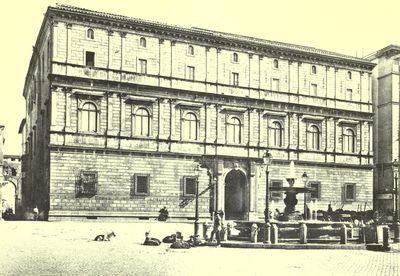
Palazzo Giraud
(After Bramante da Urbino. Rome)
Anderson
Very great was the loss that architecture suffered in the death of Bramante, who was the discoverer of many good methods wherewith he enriched that art, such as the invention of casting vaults, and the secret of stucco; both of which were known to the ancients, but had been lost until his time through the ruin of their buildings. And those who occupy themselves with measuring ancient works of architecture, find in the works of Bramante no less science and design than in any of the former; wherefore, among those who are versed in the profession, he
can be accounted one of the rarest intellects that have adorned our age. He left behind him an intimate friend, Giuliano Leno, who had much to do with the buildings of his time, but was employed rather to make preparations and to carry out the wishes of whoever designed them, than to work on his own account, although he had judgment and great experience.
During his lifetime, Bramante employed in his works one Ventura, a carpenter of Pistoia, who was a man of very good ability, and drew passing well. This Ventura, while in Rome, delighted much in taking measurements of antiquities; and afterwards, wishing to live once more in his native place, he returned to Pistoia. Now it happened in that city, in the year 1509, that a Madonna, which is now called the Madonna della Umiltà, worked miracles; and since many offerings were brought to her, the Signoria that was then governing the city determined to build a temple in her honour. Whereupon Ventura, confronted with this opportunity, made with his own hand a model of an octagonal temple ...
[15] braccia in breadth and ... braccia in height, with a vestibule or closed portico in front, very ornate within and truly beautiful. This having given satisfaction to the Signoria and to the chief men of the city, the building was begun according to the plans of Ventura, who, having laid the foundations of the vestibule and the temple, completely finished the vestibule, which he made very rich in pilasters and cornices of the Corinthian Order, with other carved stonework; while all the vaults in that work were made in like manner, with squares surrounded by mouldings, also in stone, and filled with rosettes. Afterwards, the octagonal temple was also carried to the height of the last cornice, from which the vaulting of the tribune was to rise, during the lifetime of Ventura; and since he was not very experienced in works of that size, he did not consider how the weight of the tribune might be safely laid on the building, but made within the thickness of the wall, at the first range of windows, and at the second, where the others are, a passage that runs right round, whereby he contrived to weaken the walls so much, that, the edifice being without buttresses at the base, it was dangerous
to raise a vault over it, and particularly on the angles at the corners, upon which all the weight of the vault of that tribune must rest. Wherefore, after the death of Ventura, there was no architect with courage enough to raise that vault: nay, they had caused long and stout beams of timber to be brought to the place, in order to make a tent-shaped roof; but this did not please the citizens, and they would not have it put into execution. And so the building remained for many years without a roof, until, in the year 1561, the Wardens of Works besought Duke Cosimo that his Excellency should so favour them as to cause that tribune to be vaulted. Whereupon, in order to meet their wishes, the Duke ordered Giorgio Vasari to go there and see whether he could find some method of vaulting it; and he, having done this, made a model raising the building to the height of eight braccia above the cornice that Ventura had left, in order to make buttresses for it; and he decreased the breadth of the passage that runs right round between the walls, and reinforced the building with buttresses, besides binding the corners and the parts below the passages that Ventura had made, between the windows, with stout keys of iron, double at the angles; which secured the whole in such a manner that the vault could be raised with safety. Whereupon his Excellency was pleased to visit the place, and, being satisfied with everything, gave orders for the work to be executed; and so all the buttresses have been built, and a beginning has already been made with the raising of the cupola. Thus, then, the work of Ventura will become richer, greater in size and adornment, and better in proportions; but he truly deserves to have record made of him, since that building is the most noteworthy modern work in the city of Pistoia.


